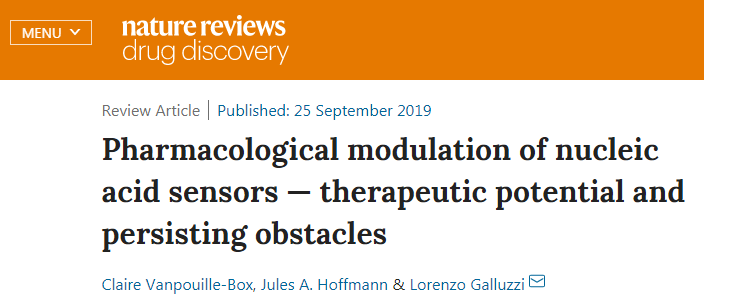
Nature Reviews Drug Discovery, 25 September 2019, DOI: https://doi.org/10.1038/s41573-019-0043-2
Pharmacological modulation of nucleic acid sensors — therapeutic potential and persisting obstacles
Claire Vanpouille-Box, Jules A. Hoffmann & Lorenzo Galluzzi
1 Department of Radiation Oncology, Weill Cornell Medical College, New York, NY, USA.
2 Sandra and Edward Meyer Cancer Center, New York, NY, USA.
3 University of Strasbourg Institute for Advanced Studies, Strasbourg, France.
4 CNRS UPR 9022, Institute for Molecular and Cellular Biology, Strasbourg, France.
5 Sino-French Hoffmann Institute, Guangzhou Medical University, Guangzhou, China.
6 Department of Dermatology, Yale School of Medicine, New Haven, CT, USA.
7 Université Paris Descartes, Paris, France.
Abstract
Nucleic acid sensors, primarily TLR and RLR family members, as well as cGAS–STING signalling, play a critical role in the preservation of cellular and organismal homeostasis. Accordingly, deregulated nucleic acid sensing contributes to the origin of a diverse range of disorders, including infectious diseases, as well as cardiovascular, autoimmune and neoplastic conditions. Accumulating evidence indicates that normalizing aberrant nucleic acid sensing can mediate robust therapeutic effects. However, targeting nucleic acid sensors with pharmacological agents, such as STING agonists, presents multiple obstacles, including drug-, target-, disease- and host-related issues. Here, we discuss preclinical and clinical data supporting the potential of this therapeutic paradigm and highlight key limitations and possible strategies to overcome them.
文章链接:https://www.nature.com/articles/s41573-019-0043-2#citeas